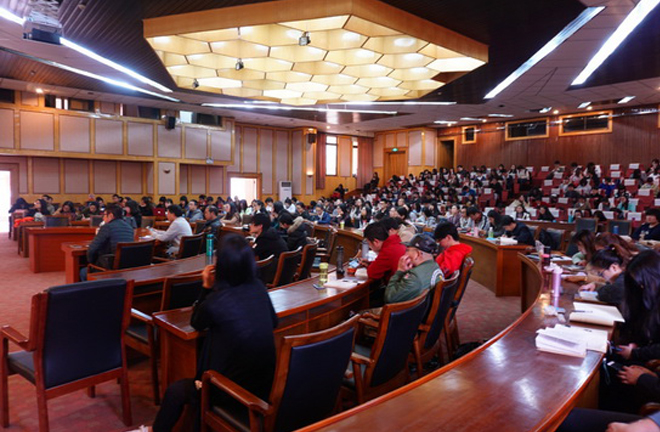Artistic aesthetics fuels cultural governance

Scholars attend the seventh Forum on the Revitalization of Chinese Culture and the Seminar on Cultural Governance and Aesthetic System on March 11 and 12.
On March 11 and 12, the seventh Forum on the Revitalization of Chinese Culture and the Seminar on Cultural Governance and Aesthetic System organized by the School of Humanities of Yunnan University and the College of Media and International Culture of Zhejiang University was held in Kunming, Yunnan Province. Scholars discussed such topics as criticism and management of aesthetic systems, cultural governance and contemporary aesthetics development, as well as theories and practice on aesthetic anthropology and anthropology of art, from aesthetic, artistic, anthropological and sociological perspectives.
Breakthrough
New cultural phenomena and modes of emotion spring up with global economic growth. Research on aesthetic systems, emotional structures and sensory distribution from an anthropological perspective will broaden the academic vision of contemporary aesthetics.
Wang Jie, a professor from the College of Media and International Culture of Zhejiang University, is a pioneering scholar engaged in aesthetic anthropology research. He said the discipline of aesthetic anthropology contains the aesthetic theories of contemporary aesthetic experiences and cultural phenomena obtained by using anthropological ideas and methods.
Fang Lili, dean of the Institute of Anthropology of Arts at the Chinese National Academy of Arts, said anthropology of art can boost the study of Chinese local arts from a new angle in the current Chinese cultural context. This can help scholars understand the interactive relationship connecting local Chinese art with the nation’s social structures and cultural values, which is crucial for the construction of artistic anthropological theory with Chinese Characteristics.
Research on basic issues of contemporary aesthetics aims not only to seek the essential issue of aesthetics, but to discuss the worldwide logic between the formulation of questions and basic issues of contemporary aesthetics. Wang Daqiao, a professor from the College of Liberal Arts at Lanzhou University, pointed out that contemporary aesthetics references anthropological theories, materials and methodology, researching areas uncovered by traditional forms of aesthetics. For example, contemporary aesthetics examines the aesthetic temperament and expression of non-Western cultures, along with the aesthetic experiences and preferences of small societies and marginal populations.
Social function
Throughout history, aesthetics and art have played special roles in cultural governance. Xiang Li, a professor from the School of Humanities at Yunnan University, said aesthetics and art cannot practice this function independently, but take effect as a special mechanism within the penetration and interaction of various institutional factors and organizations. Xiang said the aesthetic system follows the structure and rules of the definition of beauty and access to aesthetics. It is necessary to take into consideration the social role of the aesthetic system in aesthetic and artistic construction.
Aesthetic systems are the core question of aesthetic anthropology. Wang said aesthetic systems include the internal and external systems that are closely connected to each other. The internal system involves some cultural conceptions, expressions and exchanges of emotions, while the external system adapts to forms of social production, economic systems, cultural traditions and daily life, thus forming a set of cultural rules. For example, the explicit law, policy and mechanism for artistic production and consumption, and the implicit customs, cultural traditions and symbolic system, and structure of feeling formed by individual emotional logic, he said.
Fang pointed out that traditional Chinese rites and music, for example, aim not only to create entertainment and aesthetic benefits, but to create a social space via an artistic system. In the space, people’s daily lives become highly humanized, regular and knowledge based.
Marx’s aesthetics
Marx put forward the “the law of beauty” proposition in his Economic and Philosophical Manuscripts of 1844. Wang said aesthetics not only focuses on the material field, but lays more emphasis on human emotions, so that in the modernization process people can advance with the times.
Xiang said that unlike Western Marxist aesthetics, Chinese Marxist aesthetics focuses on the great role that aesthetic ideology plays in building new social relationships. Fang assumes that analysis of artistic work should not only emphasize its “uniqueness” but also link it to the external social environment for further analysis of its social and cultural characteristics. Such research will emphasize the cultural scene of artistic expression, attach importance to the functions and significance of art in the formation of social systems and the inheritance of national culture, and examine art as a form of cultural knowledge.

 PRINT
PRINT CLOSE
CLOSE